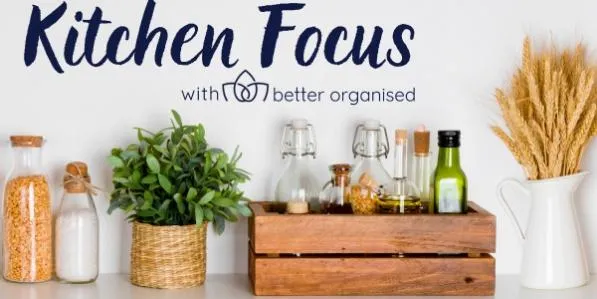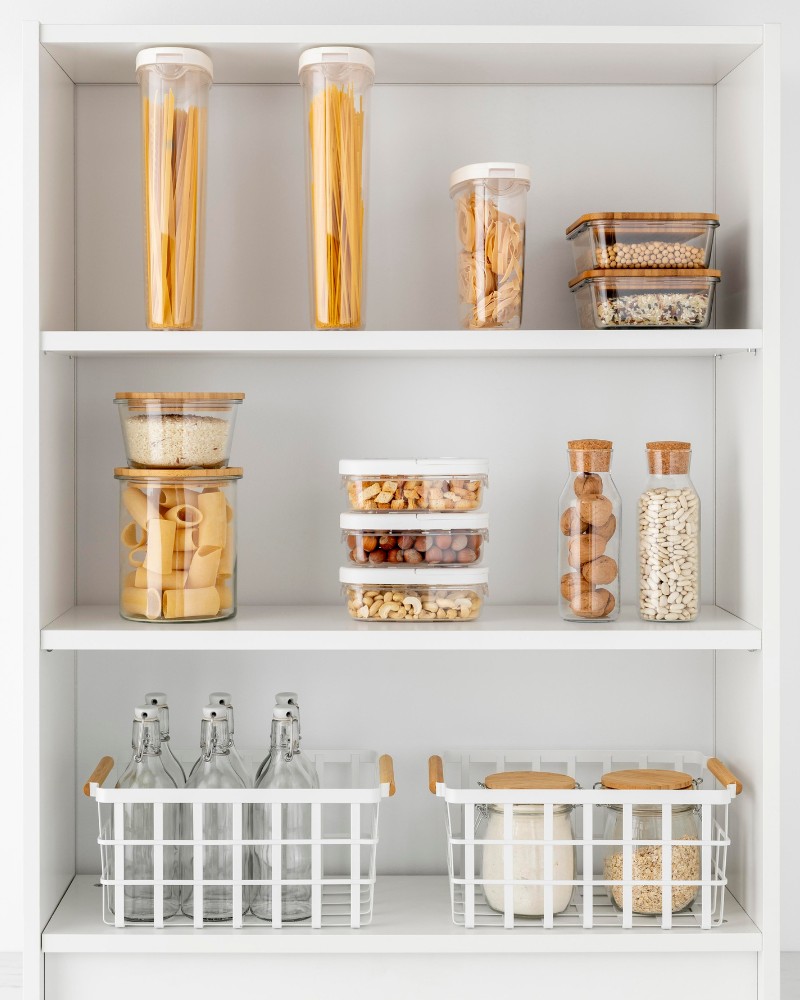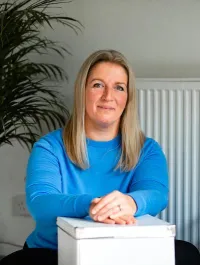BLOG
All the latest news, stories & advice.

A Better Organised Kitchen in Five Steps
The kitchen is the heart of the home and with recent open plan living trends it is also more visible than ever. If you are a foodie or amateur baker – and even if you are not – kitchen surfaces and cupboards can get cluttered pretty quickly with ingredients, containers, pots, pans and more.

“If you can organise your kitchen, you can organise your life.”
- Louis Parrish
A family of four wastes £60 every month by chucking food away. What’s more, the average UK household could make seven extra meals every week if it said goodbye to unnecessary food waste. (Source)
A well-organised space can make a difference to the smooth running of this hard-working area and help you lead a healthier and calmer lifestyle. Some simple, logical systems can make your kitchen more efficient and save you time and money by making it easier to find what you need, when you need it. Clutter makes kitchens harder to clean and maintain; it is also most inductive of food waste, so I have made a roundup of the usual clutter culprits in our kitchens and how you can take back control of your space.
Reorganise your cupboards
Do things get lost forever in the depths and corners of kitchen cabinets? Start by having a good rummage and taking everything out into the light. Be honest and ruthless, if things have been lingering there for a year or more without you using them once, do you really need to hold on to them? They can be an opportunity to make some cash as well as free up valuable space.
Re-organise kitchen cabinets by placing bulky items that you don’t use every day in the back or corner – like vases, tall jugs, or your box of champagne flutes.
Be strategic and store most frequently used items at eye level. A lazy Susan to store oils, baking goods and spices can work particularly well in awkward corner cupboards that have double doors.
Add baskets to group and store items that go naturally together, like bakeware for instance. If it is a corner cupboard, simply tuck one basket into the corner and another in the area that’s immediately accessible, so that accessing the former is simply a matter of sliding out the latter.
Conquer the snack & cereal shelves
In a busy household, the snack area can be an uphill battle. It can seem that as soon as everything is in reasonable order, the kids go foraging and it’s back to chaos – but there are a few things you can do to keep that snack cupboard under control.
Get rid of bulky packaging as soon as you unpack your shopping i.e. get individual crisp packets out of the big multipack bags, small bags of cookies out of the outer pack etc., and coral the individual packs in large, open baskets that are easy to rummage through but also let you keep tabs on stock levels.
Tear the flaps off the tops of boxes of crackers, oatcakes, biscuits, fruit winders etc., so that the snacks are still contained but you can see them at a glance and grab items quickly. Freezer clips can be used to keep crackers and oatcakes fresh once the inner bag has been opened.
Cereal boxes are sometimes too bulky to be stored in cupboards and they don’t look great on display once opened either – unless you want to have a quick look at this tutorial that teaches you how to close cereal boxes – it’s a game-changer. Other solutions include;
– Investing in pretty glass jars (just to stay away from plastics) – Ikea stores some good options
– Use clear cereal dispensers (OXO Good Grips are durable and good quality)* https://amzn.to/3wZLPl7
– Cut the top third off cereal boxes (they are never full to the brim) and use a freezer clip to keep the inner bag airtight, just so they can fit in a regular cupboard
– Adjust the height of a shelf to accommodate the boxes – this can be a very quick and easy solution, as most kitchens will have at least a couple of cupboards where the shelves are easily adjustable
– Buy smaller boxes!
Bring order to your spice collection
Spices tend to pile up with every weekly shop and can clutter cupboards and kitchens for years after being purchased. It doesn’t help that they come in different containers of all shapes and sizes, so it can be tricky to find the most space-efficient way to store them. A good thought starter is to associate like with like. Baking ingredients like baking powder, vanilla, cinnamon and cocoa can go in one basket, vinegars, soy, Worcestershire sauces in another, your spices in another. Depending on what you are preparing to make, you will know which basket you should pull off the shelf and can locate your ingredients a lot more quickly than if they are all together in one large pile.
Measure your shelf or cupboard and find baskets or boxes that fit comfortably. This is particularly important before investing in new storage – we’ve all made the mistake of getting excited about a nice storage box just to find out the measurements do not fit the space available. Alternatively, items that can simply be repurposed for storing spices include Tupperwares (the ones that are missing their lids), shoeboxes and ice cream tubs..
Banish clutter from your container drawer
Swimming in containers without lids and lids that don’t match? Firstly, I recommend a good declutter! Lay out all your containers on the worktop and match lids with tubs. Repurpose, recycle or discard, as appropriate. Any tubs without lids can be used as baskets, to contain baking goods, spices, packet mixes, sweets or snacks. They can even be used in the fridge to store small cheeses, yogurt tubes, cooked meats or condiments. Or use them elsewhere in the home, for stationery supplies, toiletries or craft materials.
Be ruthless and honest about how many containers you actually use and therefore need to keep. If they are always lying empty in the cupboard then perhaps you’re not actually using them and can let the majority of them go?
If you are investing in some new containers, Lakeland has some great stackable and colour match options and IKEA does some beautiful glass ones.
Stop avoiding the chaos drawer
Last but not least, tackle the drawer of doom – you know the one, the drawer of chaos where the random screwdriver/birthday candles/low use utensils are kept in a tangle, the one you dread opening for fear of items spilling out.
The best approach for taking control of a messy drawer is to divide and conquer! Use this as a mindfulness opportunity, switch on relaxing music or a fun podcast and get to work. Empty everything out and go through the contents, asking yourself ‘where does this belong?’. If items have an obvious place where they belong in your home, then relocate them. For items that are staying, you ideally want to be able to open the drawer and see all its contents at a glance, so that it is easy to see/grab what you are looking for, so group like with like.
You can buy drawer organisers in Home Bargains, IKEA and online, but it is usually easy to repurpose items you already have! Ferrero Rocher boxes, Apple product boxes and their lids, Tupperwares and small glasses are all good options for containing items. For example, I use a Nutella jar for corn-on-the-cob holders and cocktail sticks, an old iPhone box for pens and a clear freezer bag for birthday candles and their holders.
You may think ‘but what if I need it later?’. If you have trouble letting go of things that have been hanging about for a long time but you keep doubting yourself and thinking you might need them in the future, ask yourself what you value the most – the space or the item? Do a quick cost-benefit analysis and try to be practical about priorities. If you are seriously struggling for space, is space better than the risk you run of not having it in case you might need it later?!
I hope you found my recommendations for a better organised kitchen useful and a good place to start getting back control.
Still feeling overwhelmed by the task? I offer virtual and in-person services to help. Take the first step with a free consultation with me – simply use my calendar here to book a first conversation around your decluttering and organising goals.
FREE INITIAL CONSULTATION!
Let's arrange a time to chat on the phone about your
goals and how I can help you to move forward.
© Copyright 2024 Better Organised - Privacy Policy - Terms & Conditions

